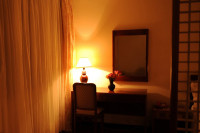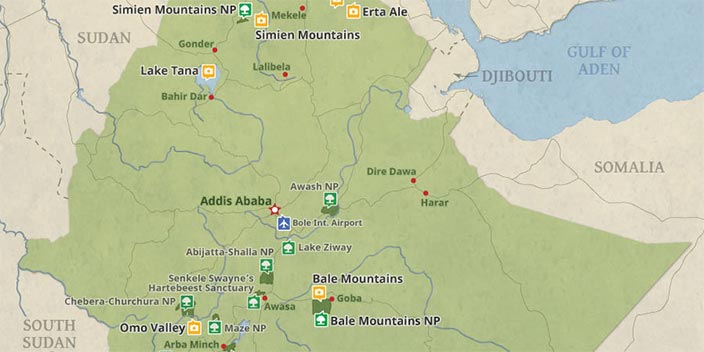
$4,730 pp (USD)
2 travelers on Start dateArrival
Arrival

Day 1
Arrival to Addis Ababa Ethiopia
Arrival to Addis Ababa Ethiopia
Meet our team on arrival at Bole International Airport and be transferred to your hotel. Located in the center of the country, Addis Ababa is Ethiopia’s geographic, political and cultural hub. Addis is distinct from many other African capitals because it was not developed under colonial rule. One of its best-known sites is the National Museum of Ethiopia, which houses the remains of “Lucy,” a bipedal hominid who lived 3.2 million years ago and was discovered in 1974. We will gather for a welcome dinner with our fellow travelers this evening.
- Main Destination:
- Addis Ababa (City)
- Accommodation:
- Da'amat Hotel
- Meals & Drinks:

Day 2
Flight to Gondar – Simien Mountains
Flight to Gondar – Simien Mountains
Will take the morning flight to Gondar, a 17th century royal city of Ethiopia. Afterwards, we will head for the World Heritage Site of Simien Mountains National Park. The drive between Gondar and Debark is very scenic. In the afternoon, from our dramatically-situated lodge (Simien Lodge), we will start our photographic exploration of the extraordinary Simien Mountains.
- Main Destination:
- Simien Mountains National Park
- Accommodation:
- Simien Lodge
- Meals & Drinks:

Day 3
Explore Simien Mountains National Park
Explore Simien Mountains National Park
The Simien Mountains is the refuge for the endangered endemic Ethiopian (or Simien) wolf, the extraordinary gelada baboon and the endangered walia ibex, a wild goat unique to Ethiopia. It is also home to endemic birds such as the thick-billed raven and wattled ibis. In addition to its wonderful scenery and wildlife, the park is also famous for its Afromontane forest, Hypericum woodland, Afromontane grassland and Afro-alpine moorland dominated by giant lobelias. We will explore the scenic Simien escarpment in order to find the endemic gelada baboons. Nicknamed ‘bleeding heart baboon’ and ‘lion-monkey’ for reasons that will soon be obvious to all, gelada baboons are peculiar to Ethiopia and Eritrea, still being numerous in the Simien Mountains. Geladas are mainly vegetarian, living on herbs, grasses and roots, but they also eat insects including and locusts. Geladas live along the rim and steep slopes of the escarpment, which is their refuge when danger threatens.
- Main Destination:
- Simien Mountains National Park
- Accommodation:
- Simien Lodge
- Meals & Drinks:

Day 4
Explore Simien Mountains National Park
Explore Simien Mountains National Park
Created by massive erosion, the Simien Mountains is one of the most spectacular landscapes in the world: jagged mountain peaks with many summits over 4,000m (roughly 13,000ft), deep valleys and 1,500m sheer precipices.
After an early breakfast, we will leave the lodge for Chenek guard post, taking a picnic lunch. The scenery around Chenek is even more awesome than further west near our lodge, with huge peaks, crags and cliffs in the foreground and distant granite domes below the Simien escarpment. Here we can look for the endemic walia ibex. As well as photographic opportunities with the ibex, we will also be hoping for an encounter with the handsome Ethiopian (or Simien) Wolf, a declining species that still occurs regularly around Chenek. We also have a high chance of spotting wildlife such as Ethiopian klipspringer, Menelik’s bushbuck, bush duiker and raptors including the huge steppe eagle, tawny eagle and the magnificent bearded vulture or lammergeier.
- Main Destination:
- Simien Mountains National Park
- Accommodation:
- Simien Lodge
- Meals & Drinks:

Day 5
Drive to Gondar
Drive to Gondar
In the morning after breakfast, we will drive back to Gondar. This city in northern Ethiopia is famed for its 17th-century stone castles and fortresses that evoke the feel of an African Camelot. Founded in 1636 by the great Emperor Fassiladas, this UNESCO World Heritage Site that was once the royal capital of Ethiopia enjoys a striking setting atop tree-studded hills. We will visit various castles and churches built by Fassiladas and his descendants, including the emperor’s own palace. The most impressive is Debre Birhan Selassie church, whose walls and ceilings are intricately decorated with scenes of biblical lore and medieval history.
- Main Destination:
- Gondar (City)
- Accommodation:
- Haile Resort Gondar
- Meals & Drinks:

Day 6
Flight to Addis then Fly to Dire Dawa
Flight to Addis then Fly to Dire Dawa
We take a morning flight to Addis, from Addis Ababa we will take a flight eastwards to the city of Dire Dawa. From there, we'll drive up into the Chercher Mountains to the city of Harar, where we will spend two nights. We will arrive in time to enjoy a first exploration of the city and then have our first session this evening with the ‘Hyena Men’. Harar is an ancient city also called “The City Of Peace”. This city was already important by the 13th century and later became the capital of the Adal Sultanate and its successor state, the Emirate of Harar, in the 16th century.
The various legends about feeding hyenas include stories that they were publicly fed porridge so that they could act as impromptu soothsayers through their style of eating it. It's also said that they were fed to discourage them from eating livestock or even people during droughts, or even that Muslim saints communicated with their clan leaders and persuaded them not to do harm in return for handouts.
- Main Destination:
- Harar (Town)
- Accommodation:
- Wonderland Hotel
- Meals & Drinks:

Day 7
Harar City
Harar City
This morning, we 'll explore the ancient Medina of Harar and its surrounding fortifications, known as the Jugal (or Jugol). The walled old city dates back to around the 16th century and is a fascinating warren of small alleyways, markets, mosques and ancient buildings. Harar is widely considered to be the 4th holiest city in Islam, after Mecca, Medina and Jerusalem, but today it is famed for its tolerance of other faiths. Harar is a wonderful place for photography, especially if you get out early while the light is at its best. We will also enjoy a photographic session with one of the ‘kite men’ of Harar. Feeding the yellow-billed kites is a recent development, not some ancient tradition, but it is fun to watch and photograph the kites swooping down and often squabbling in mid-air over small pieces of meat from a ‘kite man’s’ hands.
At dusk, we will of course return for a second session outside the town walls with our ‘Hyena Man’, something none of us will ever forget!
- Main Destination:
- Harar (Town)
- Accommodation:
- Wonderland Hotel
- Meals & Drinks:

Day 8
Drive to Alideghe Wildlife Reserve
Drive to Alideghe Wildlife Reserve
In the morning after breakfast, we will drive down into the arid Awash Valley region. The dry plains of this part of the Awash River region hold the near-endemic sacred (or Hamadryas) baboon, as well as soemmering’s gazelle, beisa oryx, the long-necked northern gerenuk and the delightful little salt’s dikdik. There is a good chance of photographing the newly ‘promoted’ wolf (golden jackals) of Africa in this area. With a bit of luck, we will also encounter northern lesser kudu.
With persistence and just a bit of luck, we will come across an Arabian bustard with one or more northern carmine bee-eaters riding on its back! Birdlife is varied and among the most appealing photographic targets are the huge Somali ostrich, lappet-faced vulture, tawny eagle, pallid and montagu’s harriers, pygmy and lanner falcons, buff-crested, hartlaub’s and white-bellied bustards, black-headed lapwing, the superb Abyssinian roller, hornbills, Somali fiscal and the lovely rosy-patched bushshrike.
- Main Destination:
- Aledeghi Wildlife Reserve
- Accommodation:
- Doho Lodge & Hot Springs
- Meals & Drinks:

Day 9
Drive to Awash National Park
Drive to Awash National Park
In the morning after breakfast, we will spend the early morning in the area if need be and then head to the nearby Awash National Park. We will go for game drive in the thorny bushes and grassland of Awash National Park, including the hike in the riverbank forest by the Awash River Falls. We will have a chance to spot mammals such as the salt’s dikdik, lesser kudu, warthog, hamadryas baboon, olive baboon, black-backed jackal, spotted hyena, Abyssinian hare, aardwolf, aardvark, grivet monkey, Nile crocodiles in the shores of the river and more wildlife and numerous birds.
- Main Destination:
- Awash National Park
- Accommodation:
- Genet Hotel Awash
- Meals & Drinks:

Day 10
Drive to Lake Ziway
Drive to Lake Ziway
In the morning after breakfast, we'll drive towards the Great Rift Valley. After some time, we will arrive at Lake Ziway, where we will overnight at a comfortable hotel right at the lakeside. Lake Ziway is a great place for photography the kind we will not enjoy while in the Bale or Simien. We can walk out directly onto either of the two promontories that start at our hotel. Enjoy the spectacle of numerous water birds, most of which are highly approachable. (An important aspect of Ethiopia, and one which makes it so good for wildlife photography, is that birds and indeed most creatures are not harmed by local people.) Large flocks of great white pelicans are a feature here and we are likely to get surprisingly close to these huge and impressive birds. Among the many other stars are the jewel-like Malachite kingfisher, the long-toed African jacana, the huge Goliath heron, the strange hamerkop, the noisy African fish eagle and the superb saddle-billed stork and numerous other species.
- Main Destination:
- Lake Ziway
- Accommodation:
- Haile Resort Ziway
- Meals & Drinks:

Day 11
Drive to Sankalle Wildlife Reserve
Drive to Sankalle Wildlife Reserve
We will set off early and drive the short distance to the northern end of Lake Langano. The grounds of a rather run-down hotel usually hold many cryptically-colored slender-tailed nightjars. While looking for these nightbirds we are likely to find and photograph the endemic black-winged lovebird and red-throated wryneck, as well as namaqua dove, white-bellied go-away-bird, the weird-looking speckled mousebird, little bee-eater, Eurasian hoopoe, black-billed wood hoopoe, and colourful greater blue-eared, Rüppell’s and superb starlings.
From Langano, we'll continue south to the town of Shashamane for lunch. Then, during the late afternoon, we will explore the rarely-visited Senkelle Wildlife Sanctuary, last stronghold of the endemic Swayne’s hartebeest. These impressive chestnut-coloured antelopes are still common here and the grasslands also feature white-bellied bustard and the gorgeous northern carmine bee-eater. Then we will head to Awassa for our overnight stay.
- Main Destination:
- Senkele Swayne’S Hartebeest Sanctuary (Wildlife Sanctuary)
- Accommodation:
- Haile Resort Hawassa
- Meals & Drinks:

Day 12
Drive to Bale Mountains
Drive to Bale Mountains
Our hotel is situated right at the lakeshore and the grounds and surroundings are a great place for early morning photography. Along the adjacent lakeshore, more photogenic birds include the delightful little African pygmy goose, African fish eagle, squacco heron, the perky little black crake and woodland kingfisher. African spotted creeper, a very uncommon and patchily-distributed bird, also occurs here, but we cannot honestly claim it will be at the top of most folk’s targets! After the day starts to heat up, our thoughts will turn to cool, high mountains, so we will head up into the Bale Mountains for a four nights stay at Goba. This afternoon, we will enjoy our first photography session in these beautiful mountains.
- Main Destination:
- Bale Mountains National Park
- Accommodation:
- Wabe Shebelle Hotel Addis Ababa
- Meals & Drinks:

Day 13
Explore Bale Mountains National Park
Explore Bale Mountains National Park
We will be spending much of our time exploring the wild and spectacular Afro-alpine moorlands of the high Sanetti Plateau, one of the best places in the Bale Mountains to find the Ethiopian wolf. The handsome Ethiopian (or Simien) wolf has had a difficult time in recent decades, suffering from distemper epidemics introduced by domestic dogs (incursions of which have become more common as the region’s human population has increased). This is now the world’s rarest canid, although, happily, a recent campaign to vaccinate local dogs, organized by the Ethiopian Wolf Conservation Programme has brought about a welcome rebound in the population.
The wolves tend to go around singly or in small groups and during the course of our visit we should have repeated encounters with them, watching them patrol their territories, greet each other, relax or hunt rodents and other prey. While we should be able to see them catch rodents, you can consider yourself lucky if you witness a close-up ‘kill’.
- Main Destination:
- Bale Mountains National Park
- Accommodation:
- Wabe Shebelle Hotel Addis Ababa
- Meals & Drinks:

Day 14
Explore Bale Mountains National Park
Explore Bale Mountains National Park
The number of rodents here is quite extraordinary, and of course they provide a bonanza for predators. It is estimated that their density is such that combined weight of rodents per square kilometer (or about 0.4 square mile) is no less than 4 tons! The great majority on the moorlands (and the main prey species of the Ethiopian wolf) consist of three Ethiopian endemics: Blick’s grass rat, black-clawed brush-furred rat and the extraordinary, endangered giant mole rat. The latter, a huge blind rodent with very goofy teeth, is constantly enlarging its burrows to reach new food supplies. We will have some fun trying to sneak up on them to take some photos. They have good hearing and also detect vibrations, so in spite of their blindness, a close approach is not easy!
- Main Destination:
- Bale Mountains National Park
- Accommodation:
- Wabe Shebelle Hotel Addis Ababa
- Meals & Drinks:

Day 15
Explore Bale Mountains National Park
Explore Bale Mountains National Park
While the handsome mountain nyala is regularly seen on the moorlands, the landscape is open and approaching them closely on foot is often unsuccessful. For far better opportunities, we will head for the Bale Mountains National Park headquarters at Dinsho. Here, some of the nyalas have become unafraid of humans and will allow a close approach, as will Menelik’s bushbucks and especially the ultra-tame common warthogs, which one can get to within a couple of metres!
Dinsho is also a good place for bird photography, often including African wood owl, the huge Verreaux’s eagle-owl and the uncommon endemic Abyssinian owl. (Cape eagle-owls also occur here, but are usually too distant for good images.)
Not far away is a good area for photographing Bohor reedbucks and olive baboons.
- Main Destination:
- Bale Mountains National Park
- Accommodation:
- Wabe Shebelle Hotel Addis Ababa
- Meals & Drinks:

Day 16
Drive to Awassa
Drive to Awassa
After a final photography session in the Bale Mountains, we will return to Awassa for an overnight stay. On the late afternoon, we will go to the forest near the Lake Beautiful, black and white Guereza Colobus monkeys with long bushy tails frequent the area and, since the hotel staff give them a few tidbits, are very confiding, allowing for great shots. Mothers with tiny infants are especially appreciated. Playful grivet monkeys also occur here including numerous birdlife.
- Main Destination:
- Awasa (City)
- Accommodation:
- Haile Resort Hawassa
- Meals & Drinks:

Day 17
Flight to Addis - City Tour
Flight to Addis - City Tour
One of its best-known sites is the National Museum of Ethiopia, home of the remains of “Lucy,” a bipedal hominid who lived 3.2 million years ago and was discovered in 1974. Visit the Ethnographic Museum located in Addis Ababa University's main campus for a collection of traditional and contemporary artifacts. You'll have delicious lunch at one of the Ethiopian cultural restaurants with a traditional coffee ceremony. Afterwards, you'll visit one of the holiest churches of Ethiopia known as the Holy Trinity church. Then we will see the tombs of emperor Haile Silase with the amazing painting of the church. You'll later enjoy amazing views of Ethiopia’s capital city from Enoto. In the evening, we will enjoy a farewell dinner at a traditional Ethiopian restaurant featuring dancers and musicians representing some of the country's many ethnic groups. Then transfer to the airport for your international departure.
- Main Destination:
- Addis Ababa (City)
- Accommodation:
- No accommodation (End of tour)
- Meals & Drinks:






























